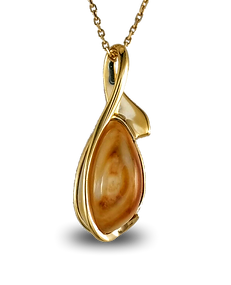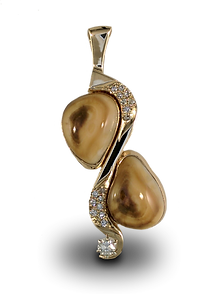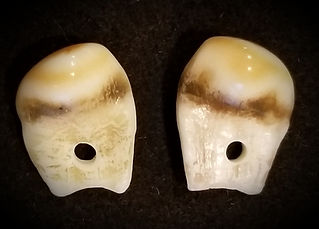ELK IVORIES FAQ


How many ivories are in an Elk’s mouth? An elk has only 2 ivories, situated forward in its upper jaw, an elk has no upper front teeth. The ivories are where the canine teeth are and are left over from their ancient ancestors who had tusks where the ivory teeth are today. Modern elk, when threatened, will snarl and expose their ivories, which was probably more impressive when they were elongated tusks. Elk have other teeth, but they are made of enamel and resemble the teeth of other herbivores. Elk and walrus are the only animals in North America that have ivory tusks.
Why are elk ivories so expensive? Since an elk only produces 2 ivories, they are not easy to come by, they are also not easy or fun to clean. When the elk is young (1-4 years), the ivories are hollow. Often when the hollow ivories are removed, the teeth are damaged and broken. Because they are hollow they are not as valuable as more mature elk teeth and the hollow root is filled with a sac of blood that turns dark and discolors the tooth if not removed during cleaning. When the elk is mature (4-7) years the tooth is solid and most prime, and the bull elk tooth develops two points on the root. After 7 years they start to wear down the ivory down due to grinding, which makes the ivory less valuable. So not only do you get just 2 teeth out of an elk, depending on the age, the tooth may not be that valuable. Therefore, GOOD teeth can be very expensive and more of a valuable commodity. Adding to their scarcity, the ivories are kept as trophies by the hunter and are used by jewelry makers to make rings, necklace charms, etc. prized by non native people for their rarity and trophy value. Primarily the jeweler is concerned with the appearance of the coloring and rings on the bottom of the crown. Some native people call this the “moccasin” as it resembles the sole of a moccasin in color and shape.
What is the difference between a bull and a cow tooth? Once you know the difference, they are easy to spot. A cow tooth has a narrow root. A bull tooth has a wide root and is generally larger overall. Mature bull teeth have a slight “u” shape at the top of the root, this develops as the elk gets older. Bull teeth are more valuable than cow teeth.
How much do real elk teeth cost? A matched pair of cow ivories typically cost between $30-40 a pair depending on size, and color. Bull teeth typically cost $40-60 a pair and the author has seen a very large set of bull elk teeth with unique coloring sell for $200!
What do native people use elk ivories for? For a very long time, the elk ivory has been a prized commodity, used for trade and a demonstration of wealth and good hunting ability. Elk ivories have been used by native people to adorn their clothing (dresses, vests, etc.) as well as for jewelry (necklaces, suspended on earrings). During the post reservation period, when game was scarce, ivories started to be carved by hand from bone and antlers to take the place of this prized possession. Many old dresses in museums have hand carved “ivories” that are made from antler. Sometimes on old dresses there would be a mix of real ivories and carved ones. Over the years there have been many versions of imitation elk teeth have been available to fill the demand for this hard to acquire commodity. Various materials like antler, bone, plastic, resin etc. have been used to make imitation elk ivories. Until now, Imitation teeth have typically had many of the same problems. They resemble elk teeth, but they are not replicas of teeth. They are either too big, don’t have natural variation, too shiny, have no color and many other issues that make the result look obviously imitation. The elk ivory replicas offered by Teton Trade Cloth are the finest available on the market today. Cast from real bull elk ivories and utilizing 18 different REAL elk ivories that have been selected as only the best, from years of collecting Western Rocky Mountain Elk. This level of realistic detail provides the artist with a beautiful variation of Ivories that is unmatched in the market today. CLICK HERE TO SHOP FOR IVORIES










Carved Ivories on an old dress

